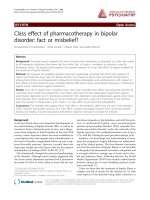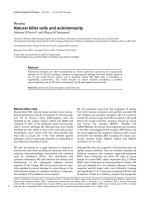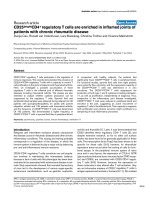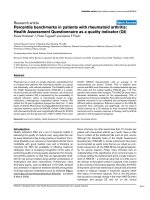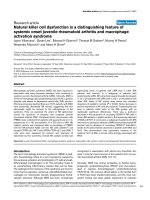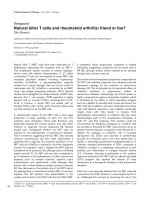Báo cáo y học: "Natural killer T cells and rheumatoid arthritis: friend or foe" ppt
Bạn đang xem bản rút gọn của tài liệu. Xem và tải ngay bản đầy đủ của tài liệu tại đây (40.6 KB, 2 trang )
88
α-GalCer = α-galactosylceramide, MHC = major histocompatibility complex, NKT = natural killer T cell, RA = rheumatoid arthritis, TCR = T cell
receptor, Th = T helper.
Arthritis Research & Therapy Vol 7 No 2 Elewaut
Natural Killer T (NKT) cells have been described as T
lymphocytes expressing NK receptors such as NK1.1.
This lymphocyte subset consists of several subpopu-
lations, each with distinct characteristics [1, 2]. Unlike
conventional T cells, the vast majority of mouse NKT cells
recognize glycolipid antigens including α-galactosyl-
ceramide (α-GalCer), a glycosphingolipid originally
isolated from marine sponges that can not be found in
mammalian cells [3]. α-GalCer is presented by an MHC
class I like antigen presenting molecule, CD1d. Several
studies have highlighted the unique features of NKT cells,
because their T cell receptor (TCR) repertoire is highly
skewed with an invariant TCR-α rearrangement, Vα14-
Jα18. In humans, a similar NKT cell subset with an
invariant TCR-α chain, Vα24, exists. Therefore, these cells
are often referred to as Vαi NKT cells.
A characteristic feature of Vαi NKT cells is their rapid
production of large quantities of both Th1 and Th2
cytokines upon stimulation. These cells, therefore, may
profoundly regulate the immune system: they may either
enhance or suppress immune responses [4]. Several
groups have investigated whether Vαi NKT cells are
relevant for the pathogenesis of autoimmune diseases.
There is evidence suggesting that Vαi NKT cells naturally
influence autoimmunity and from other experiments it
appeared that a vigorous but unnatural activation of Vαi
NKT cells by α-GalCer is required to elicit their regulatory
function. For example, in type 1 diabetes Vαi NKT cells are
considered to be protective [5], although some conflicting
reports exist [6, 7]. Vαi NKT cells are also considered to
be of relevance in the pathogenesis of other autoimmune
diseases such as multiple sclerosis, systemic lupus
erythematosus and experimental colitis although their
precise role in these diseases remains unclear at present
[4]. Few data exist on the putative role of Vαi NKT cells in
the pathogenesis of rheumatoid arthritis (RA). It has been
reported that RA patients have abnormalities in the
number and function of Vαi NKT cells that are CD4
–
CD8
–
in peripheral blood lymphocytes compared to healthy
individuals, suggesting a protective role for these cells in
RA [8], although indirect effects induced by for example
therapy have not been ruled out.
Due to their immunomodulatory properties, manipulation of
Vαi NKT cell mediated responses is an attractive potential
therapeutic strategy for the treatment of autoimmune
diseases [4]. This is illustrated by the beneficial effects of
α-GalCer treatment in experimental models of
autoimmune diseases. Interestingly, the CD1d system is
highly conserved throughout mammalian evolution, which
is illustrated by the ability of CD1d glycolipid antigens
such as α-GalCer to stimulate both mouse and human Vαi
NKT cells [9]. In addition, all human individuals have these
cells with identical specificity, and α-GalCer specifically
targets them with little toxicity in humans [10].
Nevertheless, administration of α-GalCer also has some
disadvantages such as the simultaneous stimulation of
both Th1 and Th2 cytokines. This problem could be
circumvented by designing analogues of α-GalCer that
are still able to stimulate Vαi NKT cells but give rise to an
altered immune response compared to that induced by α-
GalCer. An analogue of α-GalCer with a truncated
sphingosine tail, OCH, was reported to preferentially
promote IL-4 secretion and to be more potent than α-
GalCer in preventing autoimmune encephalomyelitis [11].
Likewise, repeated administration of OCH, compared to
α-GalCer, resulted in a substantial improvement of joint
swelling and inflammation in collagen induced arthritis
[12]. Therefore, inducing a polarization in the cytokine
response induced by Vαi NKT cells by altered glycolipid
CD1d antigens has sparked the interest of many
researchers as a therapeutic strategy to treat autoimmune
diseases.
Until now it was generally believed that Vαi NKT cells had
a protective role in RA. However, a recent paper by Kim et
al., challenged this concept by examining the role of Vαi
Viewpoint
Natural killer T cells and rheumatoid arthritis: friend or foe?
Dirk Elewaut
Laboratory for Molecular Immunology and Inflammation, Division of Rheumatology, Ghent University Hospital, Belgium
Corresponding author: Dirk Elewaut,
Published: 14 February 2005
Arthritis Res Ther 2005, 7:88-89 (DOI 10.1186/ar1714)
© 2005 BioMed Central Ltd
89
Available online />NKT cells in antibody-induced arthritis in the K/BxN serum
transfer model [13]. Transfer of serum or immunoglobulins
from K/BxN mice to healthy mice causes inflammatory
arthritis by deposition of autoantibody in joint spaces,
inducing an inflammatory cascade with activation of
complement and Fcγ receptor pathways [14]. This model
is considered to be reminiscent of the terminal effector
mechanisms of RA. The development of antibody-induced
arthritis was first examined in Jα18
–/–
and CD1d
–/–
mice
and was found to be less severe compared to wild-type
controls. In addition, adoptive transfer of NKT cells from
C57BL/6 mice into CD1d
–/–
mice reversed the observed
reduction in inflammatory arthritis, illustrating the disease
perpetuating role of Vαi NKT cells in this model.
Conversely, stimulation by repeated in vivo administration
of α-GalCer resulted in a moderate increase in clinical
paw swelling although no histological analysis was
performed. The dual functionality of Vαi NKT cells
observed in the K/BxN serum transfer model versus
collagen-induced arthritis may reflect a distinct role for
these cells in different phases of RA, with a suppressive
role in the induction phase and a provocative role in
antibody-induced joint inflammation.
A particularly fascinating and novel aspect of the current
report is the notion that Vαi NKT cells may actively
contribute to synovial inflammation by residing in a niche
where they are usually absent. Hence, Vαi NKT cells were
reported to appear within the synovium of wild-type mice
as early as three days after serum transfer. Their
appearance results in important alterations in cytokine
balances within the joints. In CD1d
–/–
mice a marked
increase in transcripts of transforming growth factor-beta
1 (TGF-β1) was observed, contrary to C57BL/6 mice in
which the levels were found to be reduced. By contrast,
IL-4 and to a lesser extent IFN-γ transcripts were found to
be reduced in CD1d
–/–
mice versus controls. However, no
differences in transcript levels of either TGF-β1, IFN-γ or
IL-4 were apparent in the spleen. The crucial role of TGF-
β1 in mediating the observed effect in NKT cell deficient
animals was shown by in vivo neutralization studies in
which anti-TGF-β1 treatment was shown to abrogate the
protective effect of Vαi NKT cells in CD1d
–/–
mice, while
not affecting joint inflammation in wild-type animals.
Although several studies have highlighted important
immunoregulatory properties for TGF-β1 in experimental
arthritis, the cellular communication network that results in
TGF-β1 secretion is only partially understood. Kim et al.,
propose that Vαi NKT cells suppress the production of
TGF-β1 by synovial cells through the production of IFN-γ
or IL-4. Whereas IFN-γ has been known to be a negative
regulator for TGF-β1 for many years, the role of IL-4
reported by Kim et al. is unexpected and warrants further
investigation [15]. Likewise, the precise mechanism(s) by
which Vαi NKT cells are attracted to synovial tissue and
the reason(s) why they get activated locally in the K/BXN
serum transfer model to induce TGF-β1 have yet to be
elucidated.
Taken together, the data illustrate the multifaceted roles of
Vαi NKT cells in autoimmune diseases, particularly RA,
and underline the important and non redundant role of
these innate-like lymphocytes in immune regulation.
Competing interests
The author(s) declare that they have no competing interests.
Acknowledgements
DE is supported by the Fund for Scientific Research-Flanders, the
Research-Fund of Ghent University and the Marató Foundation. We
thank Dr. Hilde De Winter for critical reading of this manuscript.
References
1. Godfrey DI, Hammond KJ, Poulton LD, Smyth MJ, Baxter AG:
NKT cells: facts, functions and fallacies. Immunol Today 2000,
21:573-583.
2. Elewaut D, Kronenberg M: Molecular biology of NK T cell speci-
ficity and development. Semin Immunol 2000, 12:561-568
3. Kobayashi E, Motoki K, Uchida T, Fukushima H, Koezuka Y:
KRN7000, a novel immunomodulator, and its antitumor activi-
ties. Oncol Res 1995, 7:529-534.
4. Hammond KJ, Kronenberg M: Natural Killer T cells: natural or
unnatural regulators of autoimmunity? Curr Opin Immunol
2003, 15:683-689.
5. Hong S, Wilson MT, Serizawa I, Wu L, Singh N, Naidenko OV,
Miura T, Haba T, Scherer DC, Wei J et al: The natural killer T-
cell ligand alpha-galactosylceramide prevents autoimmune
diabetes in non-obese diabetic mice. Nature Med 2001, 7:
1052-1056.
6. Wilson SB, Kent SC, Patton KT, Orban T, Jackson RA, Exley M,
Porcelli S, Schatz DA, Atkinson MA, Balk SP et al: Extreme Th1
bias of invariant Valpha24JalphaQ T cells in type 1 diabetes.
Nature 1998, 391:177-181.
7. Lee PT, Putnam A, Benlagha K, Teyton L, Gottlieb PA, Bendelac
A: Testing the NKT cell hypothesis of human IDDM pathogen-
esis. J Clin Invest 2002, 110:793-800.
8. Kojo S, Adachi Y, Keino H, Taniguchi M, Sumida T: Dysfunction
of T cell receptor AV24AJ18+, BV11+ double-negative regula-
tory natural killer T cells in autoimmune diseases. Arthritis
Rheum 2001, 44:1127-1138.
9. Brossay L, Kronenberg M: Highly conserved antigen-presenting
function of CD1d molecules. Immunogenetics 1999, 50:146-
151.
10. Giaccone G, Punt CJ, Ando Y, Ruijter R, Nishi N, Peters M, Von-
Blomberg BM, Scheper RJ, Van-Der-Vliet HJ, Van-Den-Eertwegh
AJ, et al.: A Phase I Study of the Natural Killer T-Cell Ligand
alpha-Galactosylceramide (KRN7000) in Patients with Solid
Tumors. Clin Cancer Res 2002, 8:3702-3709.
11. Miyamoto K, Miyake S, Yamamura T: A synthetic glycolipid pre-
vents autoimmune encephalomyelitis by inducing TH2 bias of
natural killer T cells. Nature 2001, 413(6855):531-534.
12. Chiba A, Oki S, Miyamoto K, Hashimoto H, Yamamura T, Miyake
S: Suppression of collagen-induced arthritis by natural killer T
cell activation with OCH, a sphingosine-truncated analog of
alpha-galactosylceramide. Arthritis Rheum 2004, 50:305-313.
13. Kim HY, Kim HJ, Min HS, Kim S, Park WS, Park SH, Chung DH:
NKT cells promote antibody-induced joint inflammation by
suppressing transforming growth factor b1 production. J Exp
Med 2005, 201:41-47.
14. Matsumoto I, Maccioni M, Lee DM, Maurice M, Simmons B,
Brenner M, Mathis D, Benoist C: How antibodies to a ubiqui-
tous cytoplasmic enzyme may provoke joint-specific autoim-
mune disease. Nat Immunol 2002, 3:360-365.
15. Marth T, Strober W, Seder RA, Kelsall BL: Regulation of trans-
forming growth factor-beta production by interleukin-12. Eur J
Immunol 1997, 27:1213-1220.
